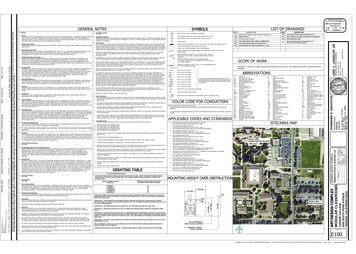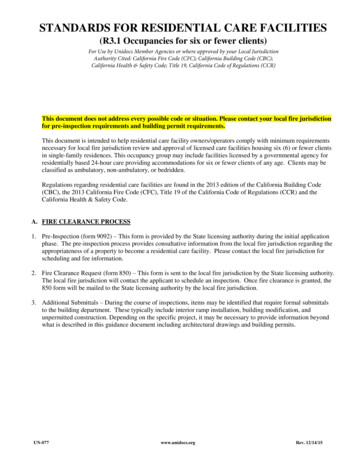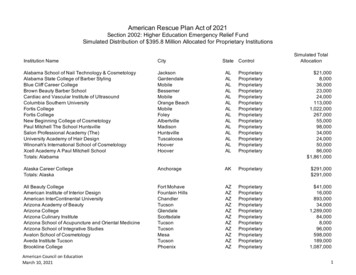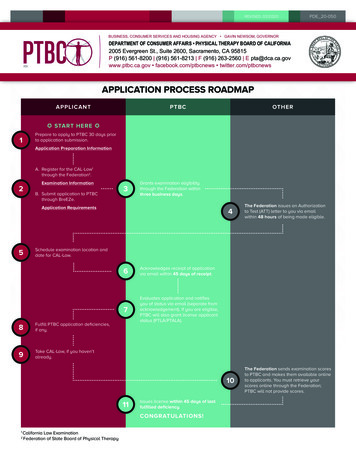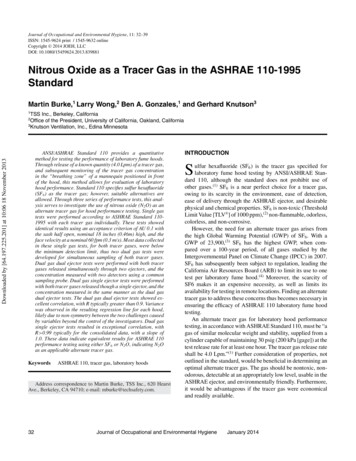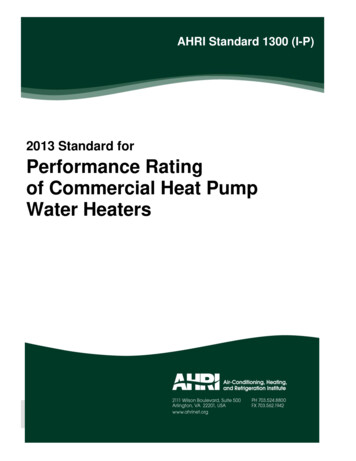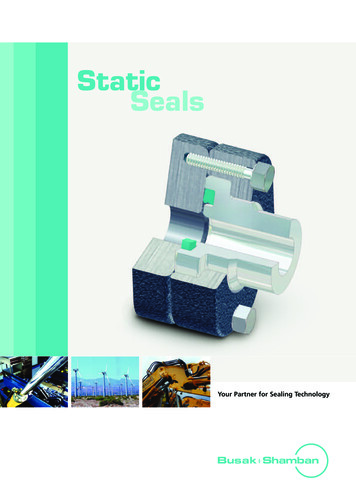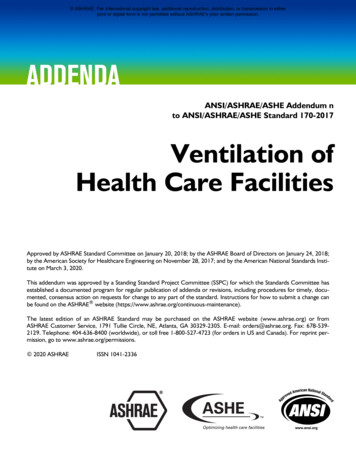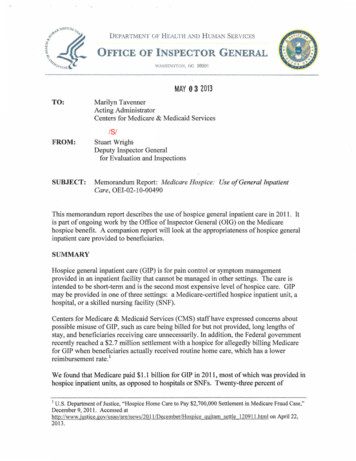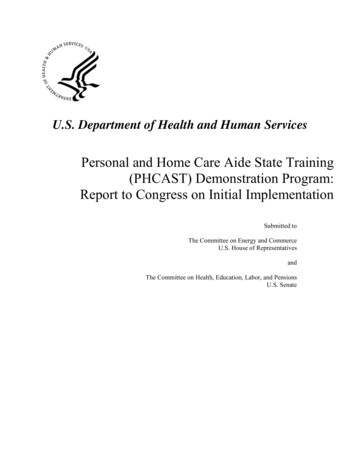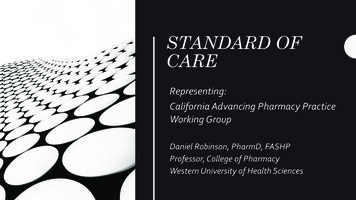
Transcription
STANDARD OFCARERepresenting:California Advancing Pharmacy PracticeWorking GroupDaniel Robinson, PharmD, FASHPProfessor, College of PharmacyWestern University of Health Sciences
Personal Experience Member - 2021-22 APhA Policy CommitteeStandard of Care Regulatory Model for State Pharmacy Practice Acts. Member – NABP Task Force to Develop Regulations Based onStandard of Care, 2018 Chair, California Advancing Pharmacy Practice Working Group (2019present)
Oath of a Pharmacist “I promise to devote myself to a lifetime of service toothers through the profession of pharmacy Vows I take these vows voluntarily with the full realization of theresponsibility with which I am entrusted by the public.”
A Social Contract There is an implicit agreementbetween health professionals andsociety.– Provide altruistic service– Maintain professional competence– Maintain morality and integrity
Delegated Self-Regulation The profession’s right to self-regulation has been delegated by society viafederal and state legislation through boards of medicine, pharmacy, dentistry,nursing, etc. Hence, boards:– Set standards for education, training, and entry into practice– Regulate practice– Ensure standards are met, and remediate or discipline unethical, immoral,or incompetent practices
SB 493 Pharmacy PracticeAmended BPC 4050 – Declares that pharmacists are health care providersBill amended 10 sections andadded 6 sections to the BPC.However,The bill did not makeconforming or technicalchanges that would allowpharmacists to fully function ashealth care providers.
What is Missing? Existing language in the Businessand Professions Code wasimplemented before the legislaturedeclared that pharmacists are healthcare providers Landmark legislation (SB493) putinto statute many decisions thatshould have been at the provider’sdiscretion.
4052.3 Self-administered sThe Board of Pharmacy and the MedicalBoard of California are both authorized toensure compliance with this subsection.Pharmacist may furnish in accordance withstandardized procedures or protocolsdeveloped and approved by the MedicalBoard of California in consultation with theAmerican Congress of Obstetricians andGynecologists
ExamplesofStatutoryHandcuffs(2)4052.01 Naloxone.Pharmacist may furnish naloxonein accordance with standardizedprocedures or protocols developedand approved by both the MedicalBoard of California in consultationwith the California Society ofAddiction Medicine.
ExamplesofStatutoryHandcuffs(3)4052.02 HIV Preexposureprophylaxis.The (pharmacy) board shall consultwith the Medical Board ofCalifornia as well as relevantstakeholders, but not limited to,the Office of AIDS (Dept of PublicHealth) on training programs.
4052.8 Vaccines (adding COVID)ExamplesofStatutoryHandcuffs(4)Pharmacists were previouslyauthorized to administer vaccines.COVID vaccine required a changein pharmacy law.No corresponding change requiredfor medicine because change isinevitable and constant.
Delegated Self-Regulation Recommended Change toPharmacy LawRemovingtheHandcuffsNo state agency other than theboard of pharmacy may define orinterpret the practice of pharmacyfor those licensed pursuant to theprovisions of this chapter ordevelop standardized proceduresor protocols pursuant to thischapter.
NABPModelStatePharmacyPracticeAct - 2021 Section 212 empowers Boards tomake such rules as are necessaryto fully administer andimplement the Act with thegreatest possible flexibility andautonomy.
Guidelines for the Structure & Function of StateMedical & Osteopathic Boards, May 2021 The medical practice act should provide for a separate statemedical board, acting as a governmental agency to regulatethe practice of medicine Furthermore, the medical practice act should not apply tothose practicing dentistry, nursing, optometry, psychology, orany other healing art in accord with and as provided by thelaws of the jurisdiction.
BPC 2725(e). Nursing Scope ofRegulations.Precedents No state agency other than the boardmay define or interpret the practice ofnursing for those licensed pursuant tothe provisions of this chapter(effective 1/1/2004) BPC 3702.5 Respiratory Therapy Except for the [Respiratory Care]board, a state agency may not defineor interpret the practice of respiratorycare for those licensed pursuant tothis chapter. (effective 1/1/2019)
Professional Scope of Practice -Scope ofPracticeServices that a profession’smembers are trained and competentto perform. Evolves to integrate newdevelopments, new knowledge andskills for that profession. Legal Scope of Practice –State laws and regulations thatdefine services that may or may notbe provided by a profession.
Changes to Legal Scope ofPractice require legislativeand regulatory action, whichare:Scope ofPractice Slow Adversarial Costly[BPC Chapter 9 Article 3 PharmacyScope of Practice and Exemptions]Note: there is no comparablelanguage in the Medical PracticeAct
CASE IN POINTTheAffordableCare Act(2010) Enroll an estimated 30 millionAmericans in health insurance andsupport innovative ways to organizeand deliver care. Multidisciplinary teams based onthe needs of the population,practice size and type would beessential to optimize outcomes andhealth resources.
From Legal Scope of Practice toStandard of Care Regulatory Model Create a regulatory environment inCalifornia that maximizes the ability forpharmacists to function as health careproviders. Standard of Care – a regulatory model used bymedicine, nursing, dentistry and others.
Pharmacy Yesterday and TodayA 60 year transition
The Practice ofPharmacy isDiverse Provision of acts or servicesnecessary to provide medicationmanagement in all practicesettings.According to Health Care ProviderTaxonomy version 22, Jan 2022(NUCC)
NAPLEX Competencies (43) Obtain, interpret, assess patient information (7, 18% of test) Identify drug characteristics (4, 14% of test) Develop or manage treatment plans (12, 35% of test) Perform calculations (9, 14% of test) Compound, dispense, administer drugs, or manage delivery systems(6, 11% of test) Develop or manage practice or medication-use systems to ensuresafety and quality (5, 7% of test)January 2021
NAPLEX Competencies (43)All but Area 5 (Compound, Dispense, AdministerDrugs, or Manage Delivery Systems) are focusedon the assessment, monitoring and treatment ofdisease, drug selection and dosing, diseaseprevention, and interdisciplinary practice, i.e., 37of 43 competency statements.
Accreditation Council forPharmacy Education (ACPE)ACPE Standards 2016 Require that pharmacy school graduates are ready to 1)provide direct patient care in a variety of health caresettings (practice-ready) and 2) contribute as a memberof an interprofessional collaborative patient care team(team-ready).
Standard of Care - Background A license to practice medicine, nursing, dentistry, pharmacy,etc., identifies licensee as possessing foundationalknowledge, skills, and abilities to practice that profession. American Board of Medical Specialties recognizes 40specialties and 87 subspecialties. The Board of Pharmacy Specialties recognizes 14 specialties
Medicine – Standard of Care ModelExa mpl es: Ev alu ati o n b ased o n St an da rd of Ca reFa mily M ed ici111 eOn co logyOrth op ed ic Su rge ryI nt e rnaI ·.· e ciiici 111 eCard io logyAdd it io naI ,Q ua I ificatio ns
Medicine - Standard of Care A physician who receives a quality-of-carecomplaint would be reviewed by a medical expertor experts with pertinent education, training, andexpertise specific to the Standard of Care issue(see 2220.08 BPC Enforcement)
Pharmacy – Standard of Care ModelCommunity PharmacistAmbulatory dditional Qualfflcations
Pharmacy - Standard of CareProposed A pharmacist who receives a quality-of-carecomplaint would be reviewed by a pharmacyexpert or experts with pertinent education,training, and expertise specific to the Standard ofCare issue
Standard of Care– Under the new regulatory model, pharmacists providinghealth care services would be held to the standard ofcare that would be provided in a similar setting by areasonable and prudent licensee with similar education,training and experience.
Advantages of aStandard of Care Model Utilizes full competence and ability of the health professional Determined by education, training, and experience Recognizes professional heterogeneity Advances with new education, technology, science, and practice standards Avoids tying fixed regulations to an entire class of health professional Avoids lengthy statutory and regulatory changes as practice and health careevolve
APhA House of DelegatesPolicy StatementStandard of Care Regulatory Model for State Pharmacy Practice Acts1. APhA requests that state boards of pharmacy and legislativebodies regulate pharmacy practice using a standard of careregulatory model similar to other health professions, therebyallowing pharmacists to practice at the level consistent withtheir individual education, training, experience, and practicesetting.
APhA House of DelegatesPolicy StatementStandard of Care Regulatory Model for State Pharmacy Practice Acts2. To support implementation of a standard of care regulatorymodel, APhA reaffirms 2002 policy that encourages states toprovide pharmacy boards with the following: (a) adequateresources; (b) independent authority, including autonomyfrom other agencies; and (c) assistance in meeting theirmission to protect the public health and safety of consumers.
NABP Task Force to DevelopRegulations Based onStandards of CareTask Force Recommendation 2018 The task force recommends that NABP encourage state boards ofpharmacy to consider regulatory alternatives for clinical careservices that require pharmacy professionals to meet the standardof care.
Question or Concerns Standard of Care Model Would all licensed pharmacists be able to provide the full scope ofservices under a standard of care model?– No!!! Only those who have the education, training,experience, and practice environment to provide the serviceor activity.
Question or Concerns Standard of Care Model Is there a credentialing process for pharmacists?– Yes!!! Pharmacists maintain a record of their credentials, whichwould include license, residency certificate, board certification,continuing pharmacy education, and training certificates. APhAprovides a comprehensive verification system through PharmacyProfiles that could be used by employers, health systems, etc.
Question or Concerns Standard of Care Model Should pharmacists be required to follow clinical practiceguidelines?– No!!! Science, health care delivery, and evidence-basedpractice are continually evolving. AHRQ National GuidelineClearinghouse, with 8,228 guidelines, was defunded in 2018because of limited usefulness.
Question or Concerns Standard of Care Model Do we really need pharmacists to play a greater role in medicationmanagement?– Yes!!! Of all the health professions, pharmacists have by far thegreatest understanding of drugs, drug selection, drugmanagement, and their safe use. Over 528 billion in avoidablespending is attributed to suboptimal use of medications in theU.S.
SummaryStandard of Care Model Implementing a standard of care regulatory model for pharmacypractice would improve access to health care services, promotehealth equity within geographic or medically underservedcommunities, and remove unnecessary barriers between patientsand vital medication management and preventative health careservices provided by pharmacists.
AcknowledgementMembers of the Advancing Pharmacy PracticeWorking GroupDaniel Robinson, ChairLisa Kroon, UCSFJeffery Goad, ChapmanMichael Hogue, Loma LindaRon Jordan, ChapmanSusan Bonilla, CPhARajan Vaidya, CPhASteve Chen, USCLoriann DeMartini, CSHPKeith Yoshizuka, Touro (CSHP)Giny Herold, Retired (Board of Pharmacy)Lisa Gunther Lum, CSHPJames Scott, Touro (CSHP)Randy McDonough, Loma Linda (Iowa)Pam Schweitzer, Former RADM, Assistant Surgeon GeneralSarah McBane, UCIRichard Dang, USC (CPhA)
Questions?If you ever want to truly understandsomething, try to change it.Thank you,Daniel Robinson, PharmD, FASHPWestern University of Health Sciencesdrobinson@westernu.edu
federal and state legislation through boards of medicine, pharmacy, dentistry, nursing, etc. Hence, boards: - Set standards for education, training, and entry into practice - Regulate practice - Ensure standards are met, and remediate or discipline unethical, immoral, or incompetent practices

